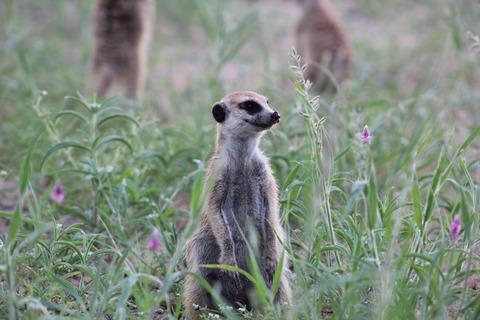当前位置:
X-MOL 学术
›
J. Anim. Ecol.
›
论文详情
Our official English website, www.x-mol.net, welcomes your
feedback! (Note: you will need to create a separate account there.)
Sex‐independent senescence in a cooperatively breeding mammal
Journal of Animal Ecology ( IF 3.5 ) Pub Date : 2020-04-01 , DOI: 10.1111/1365-2656.13173 Jack Thorley 1, 2 , Christopher Duncan 1, 2 , Stuart P Sharp 3 , David Gaynor 2, 4 , Marta B Manser 2, 4, 5 , Tim Clutton-Brock 1, 2, 4
Journal of Animal Ecology ( IF 3.5 ) Pub Date : 2020-04-01 , DOI: 10.1111/1365-2656.13173 Jack Thorley 1, 2 , Christopher Duncan 1, 2 , Stuart P Sharp 3 , David Gaynor 2, 4 , Marta B Manser 2, 4, 5 , Tim Clutton-Brock 1, 2, 4
Affiliation

|
1. Researchers studying mammals have frequently interpreted earlier or faster rates of ageing in males as resulting from polygyny and the associated higher costs of reproductive competition. 2. Yet few studies conducted on wild populations have compared sex-specific senescence trajectories outside of polygynous species, making it difficult to make generalised inferences on the role of reproductive competition in driving senescence, particularly when other differences between males and females might also contribute to sex-specific changes in performance across lifespan. 3. Here, we examine age-related variation in body mass, reproductive output and survival in dominant male and female meerkats, Suricata suricatta. Meerkats are socially monogamous cooperative breeders where a single dominant pair virtually monopolize reproduction in each group and subordinate group members help to rear offspring produced by breeders. 4. In contrast to many polygynous societies, we find that neither the onset nor the rate of senescence in body mass or reproductive output show clear differences between males and females. Both sexes also display similar patterns of age-related survival across lifespan, but unlike most wild vertebrates, survival senescence (increases in annual mortality with rising age) was absent in dominants of both sexes, and as a result, the fitness costs of senescence were entirely attributable to declines in reproductive output from mid- to late-life. 5. We suggest that the potential for intrasexual competition to increase rates of senescence in females - who are hormonally masculinised and frequently aggressive - is offset by their ability to maintain longer tenures of dominance than males, and that these processes combined lead to similar patterns of senescence in both sexes. 6. Our results stress the need to consider the form and intensity of sexual competition as well as other sex-specific features of life history when investigating the operation of senescence in wild populations.
中文翻译:

合作繁殖哺乳动物的性别独立衰老
1. 研究哺乳动物的研究人员经常将男性的衰老速度提前或加快解释为一夫多妻制和相关的更高的生殖竞争成本。2. 然而,对野生种群进行的研究很少比较一夫多妻物种之外的性别特异性衰老轨迹,因此很难对生殖竞争在驱动衰老中的作用做出普遍推断,特别是当雄性和雌性之间的其他差异也可能导致整个生命周期中表现的性别特异性变化。3. 在这里,我们研究了占优势的雄性和雌性猫鼬 Suricata suricatta 的体重、繁殖量和存活率与年龄相关的变化。猫鼬是社会上一夫一妻制的合作育种者,其中一对占主导地位的一对实际上垄断了每个群体的繁殖,而从属群体成员则帮助饲养育种者生产的后代。4. 与许多一夫多妻制社会相比,我们发现,无论是在体重或生殖输出方面,无论是开始时间还是衰老速度,男性和女性之间都没有明显的差异。两性在整个生命周期中也表现出类似的与年龄相关的生存模式,但与大多数野生脊椎动物不同,两性的优势物种都不存在生存衰老(随着年龄的增长,年死亡率增加),因此,衰老的健康成本完全归因于从中年到晚年生殖产量的下降。5. 我们认为,性内竞争增加女性衰老率的潜力 - 荷尔蒙男性化且经常具有攻击性 - 被她们维持比男性更长的统治时间的能力所抵消,并且这些过程结合导致了类似的衰老模式两性。6. 我们的结果强调,在调查野生种群衰老过程时,需要考虑性竞争的形式和强度以及生活史的其他性别特异性特征。
更新日期:2020-04-01
中文翻译:

合作繁殖哺乳动物的性别独立衰老
1. 研究哺乳动物的研究人员经常将男性的衰老速度提前或加快解释为一夫多妻制和相关的更高的生殖竞争成本。2. 然而,对野生种群进行的研究很少比较一夫多妻物种之外的性别特异性衰老轨迹,因此很难对生殖竞争在驱动衰老中的作用做出普遍推断,特别是当雄性和雌性之间的其他差异也可能导致整个生命周期中表现的性别特异性变化。3. 在这里,我们研究了占优势的雄性和雌性猫鼬 Suricata suricatta 的体重、繁殖量和存活率与年龄相关的变化。猫鼬是社会上一夫一妻制的合作育种者,其中一对占主导地位的一对实际上垄断了每个群体的繁殖,而从属群体成员则帮助饲养育种者生产的后代。4. 与许多一夫多妻制社会相比,我们发现,无论是在体重或生殖输出方面,无论是开始时间还是衰老速度,男性和女性之间都没有明显的差异。两性在整个生命周期中也表现出类似的与年龄相关的生存模式,但与大多数野生脊椎动物不同,两性的优势物种都不存在生存衰老(随着年龄的增长,年死亡率增加),因此,衰老的健康成本完全归因于从中年到晚年生殖产量的下降。5. 我们认为,性内竞争增加女性衰老率的潜力 - 荷尔蒙男性化且经常具有攻击性 - 被她们维持比男性更长的统治时间的能力所抵消,并且这些过程结合导致了类似的衰老模式两性。6. 我们的结果强调,在调查野生种群衰老过程时,需要考虑性竞争的形式和强度以及生活史的其他性别特异性特征。











































 京公网安备 11010802027423号
京公网安备 11010802027423号